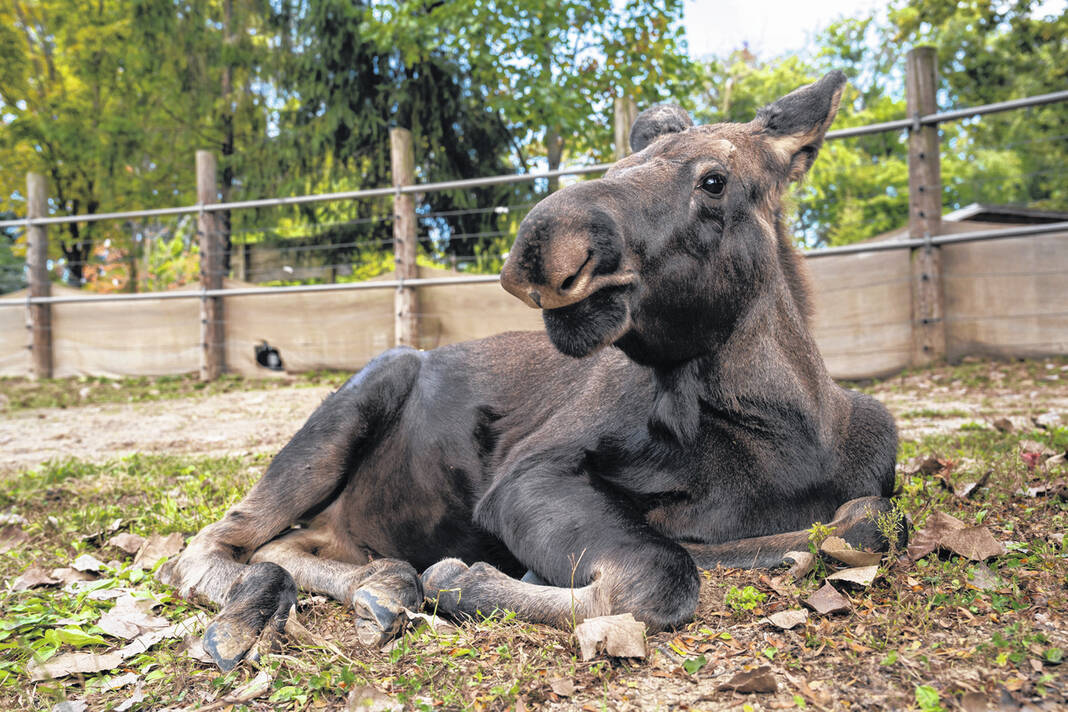
POWELL — The Columbus Zoo and Aquarium family grew with the arrival of three orphaned Alaskan moose calves.
After a long trip, the calves have settled into the moose yard, which is across from the reindeer in the North America region. They are exploring the sights and smells of their new habitat and meeting their new keepers.
“I’m so glad the calves made it safely to their new home. Our keepers and interns worked very hard with them all summer. Watching them grow and thrive from wobbly orphans into strong little moose was rewarding, and everyone here felt the bittersweet of sending them to their new home. I know they will have the best care and be loved by everyone there,” said Sam Lavin, curator at the Alaska Zoo.
The calves’ early life was fraught with uncertainty; however, our colleagues at the Alaska Department of Fish and Game, who found all three calves, and the Alaska Zoo, provided the calves an opportunity to thrive. The teams estimate the calves are about five months old.
Bert, named by Pam Bertram, a gracious donor and a lover of wildlife and moose, as a tribute to her dad, was found running along the beach near Nikiski, Alaska. Staff from the Alaska Department of Fish and Game suspect he fell off the bluff, becoming separated from his mother. After a thorough search, his mother was not located. He was brought to the Alaska Zoo in May of 2022. Bert is the largest of the calves weighing more than 300 pounds.
Sadly, Violet’s mother rejected her for unknown reasons. When the Alaska Department of Fish and Game brought her to the Alaska Zoo, she was thin and dehydrated. With the love and care of the team at Alaska Zoo, she flourished and is now at a healthy weight of more than 200 pounds.
Unfortunately, the team at Alaska Zoo doesn’t know the circumstances contributing to Scarlet’s story. She is the smallest of the trio weighing 214 pounds.
About 70% of the animals in the North America region were either displaced by natural disasters, like a wildfire, orphaned, rescued or rehabbed due to injuries. The partnership that the Columbus Zoo and Aquarium have with organizations like the Alaska Zoo and the Alaska Department of Fish and Game is vital to provide a safe place for these animals to have a second chance. It’s also an opportunity for guests to learn about the effects of climate change, human-wildlife coexistence, and much more.
In 2020, the Columbus Zoo worked with Oakland Zoo to bring three mountain lion cubs, Captain Cal, Goldie, and Poppy, to the zoo. They were rescued from wildfires that ravaged California in September 2020. Other rescues in the North America region include brown bears, Buckeye and Brutus, black bears, Joanie and Stevie, Alaskan moose Strawberry, three eagles, and much more.
Nikki Smith, a curator for the North America region, traveled with Dr. Randy Junge, VP of Animal Health, to Alaska to pick up the calves.
“All three calves did a great job on the 3,900-mile trip and seeing them immediately explore their new home was wonderful. I’m thankful to the Alaska Zoo team for their tremendous work in nurturing and caring for these three calves. Our team will build on their success, and we look forward to seeing Bert, Scarlet and Violet meet Strawberry (soon) and grow up together,” said Smith.
The new arrivals will be under mandatory quarantine for some time. The keepers will introduce them to Strawberry soon. Strawberry was also rescued by the Alaska Department of Fish and Game and the Alaska Zoo. Like the new arrivals, Strawberry was an orphan found wandering in a neighborhood, searching for her mother. She arrived at the Columbus Zoo on Oct. 12, 2021, when she was approximately 4 to 6 months old.
Moose, a wildlife icon in North America, can be found in the northern regions of the United States, from Maine to Washington, into Alaska, and throughout Canada. Known as elk in Eurasia, their populations range from northern Europe to northeastern Siberia. There are four North American subspecies (and four in Eurasia), and Bert, Scarlet, and Violet are Alaskan moose (Alces alces gigas). Alaskan moose is the largest deer in the world by mass and stands approximately 6 feet tall from hoof to shoulder while weighing more than 1,000 pounds.
While moose are not listed as a threatened or endangered species, moose populations continue to be monitored. They face serious challenges in their native ranges, including being struck by cars and habitat degradation. Additional threats to climate change include overheating, a disease linked to parasitic brain worms carried by white-tailed deer, and anemia resulting from tick infestations.


